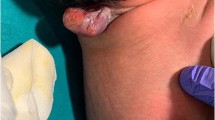Abstract
Objective
Cervical myelomeningocele (CMMC) is a rare entity in neurosurgical practice, which presents different clinical characteristics compared with other more common lumbosacral variant. Since not much about this lesion has been reported in the literature, this study, herein, demonstrates by cases the clinical characteristics, methods, and techniques of surgical treatment of CMMC in children.
Methods
A total of 10 children (six boys and four girls) with CMMC were recruited in this study. Their ages ranged from 9 days to 8 years with a median age of 3 months. All patients underwent neurological and radiological examinations. One was found to have had a mild unilateral arm weakness, and others were neurologically intact. Of these 10 patients, five had other associated neurological or orthopedic anomalies, including mild ventriculomegaly in two, cervical diastematomyelia in one, Chiari II malformation and hydrocephalus in one, and sacral spina bifida occulta in one. Surgical excision of the lesion with intradural exploration of the sac to release any potential adhesion bands was performed for all.
Results
No complications, such as cerebrospinal fluid leakage and infection, had been found after operation. During the follow-up of 1–7 years (mean of 3.9 years), all cases did not suffer from aggravation of nervous symptoms. None of the patients deteriorated postoperatively, and the one with left arm weakness improved following surgery. In the two children with mild ventriculomegaly, cerebral ventricle returned to be normal after surgery.
Conclusions
The management strategies of CMMC are early surgical treatment with standard microneurosurgical techniques to prevent the development of neurological defects. It is safe and effective to adopt surgery excision of the lesions with intradural exploration of the sac to release any potential adhesion bands.


Similar content being viewed by others
References
Sun JC, Steinbok P, Cochrane DD (2000) Cervical myelocystoceles and meningoceles: long-term follow-up. Pediatr Neurosurg 33:118–122
Ankola PA, Fernandes Y, Tunnessen WW Jr (1998) Picture of the month: cervical myelomeningocele. Arch Pediatr Adolesc Med 152:299–300
Nishino A, Shirane R, So K, Arai H, Suzuki H, Sakurai Y (1998) Cervical myelocystocele with Chiari II malformation: magnetic resonance imaging and surgical treatment. Surg Neurol 49:269–273
Steinbok P (1995) Dysraphic lesions of the cervical spinal cord. Neurosurg Clin N Am 6:367–376
Pang D, Dias MS (1993) Cervical myelomeningoceles. Neurosurgery 33:363–373
Steinbok P, Cochrane DD (1991) The nature of congenital posterior cervical or cervicothoracic midline cutaneous mass lesions: report of eight cases. J Neurosurg 75:206–212
Erşahin Y, Barçin E, Mutluer S (2001) Is meningocele really an isolated lesion. Childs Nerv Syst 17:487–490
Meyer-Heim AD, Klein A, Boltshauser E (2003) Cervical myelomeningocele. Follow-up of five patients. Eur J Paediatr Neurol 7:407–412
Kasliwal MK, Dwarakanath S, Mahapatra AK (2007) Cervical meningomyelocele—an institutional experience. Childs Nerv Syst 23:1291–1293
Salomão JF, Cavalheiro S, Matushita H, Leibinger RD, Bellas AR, Vanazzi E, de Souza LA, Nardi AG (2006) Cystic spinal dysraphism of the cervical and upper thoracic region. Childs Nerv Syst 22:234–242
Feltes CH, Fountas KN, Dimopoulos VG, Escurra AI, Boev A, Kapsalaki EZ, Robinson JS, Troup EC (2004) Cervical meningocele in association with spinal abnormalities. Childs Nerv Syst 20:357–361
Nishio S, Morioka T, Hikino S, Fukui M (2001) Cervical (myelo)meningocoele: report of 2 cases. J Clin Neurosci 8:586–587
Delashaw JB, Park TS, Cail WM, Vollmer DG (1987) Cervical meningocele and associated spinal anomalies. Childs Nerv Syst 3:165–169
Cameron AH (1956) The spinal cord lesion in spina bifida cystica. Lancet 271:171–174
Duprez TP, Laterre EC (1995) Unusual form of closed dysraphism of the cervical spine. Acta Neurol Belg 95:42–43
Wu JK, Scott RM (1990) Myelopathy presenting decades after surgery for congenital cervical cutaneous lesions. Neurosurgery 27:635–637
Vogter DM, Culberson JL, Schochet SS, Gabriele OF, Kaufman HH (1987) “High spinal” dysraphism: case report of a complex cervical meningocele. Acta Neurochir (Wien) 84:136–139
Konya D, Dagcinar A, Akakin A, Gercek A, Ozgen S, Pamir MN (2006) Cervical meningocele causing symptoms in adulthood: case report and review of the literature. J Spinal Disord Tech 19:531–533
Sulla I, Fagula J, Výrostko J, Kundrát I (1980) Case report of a patient with Klippel-Feil syndrome and occipital-cervical meningocele. Rozhl Chir 59:760–762
Andronikou S, Wieselthaler N, Fieggen AG (2006) Cervical spina bifida cystica: MRI differentiation of the subtypes in children. Childs Nerv Syst 22:379–384
Tortori-Donati P, Rossi A, Biancheri R, Cama A (2001) Magnetic resonance imaging of spinal dysraphism. Top Magn Reson Imaging 12:375–409
Steinbok P, Cochrane DD (1995) Cervical meningoceles and myelocystoceles: a unifying hypothesis. Pediatr Neurosurg 23:317–322
Author information
Authors and Affiliations
Corresponding author
Rights and permissions
About this article
Cite this article
Huang, SL., Shi, W. & Zhang, LG. Characteristics and surgery of cervical myelomeningocele. Childs Nerv Syst 26, 87–91 (2010). https://doi.org/10.1007/s00381-009-0975-7
Received:
Revised:
Published:
Issue Date:
DOI: https://doi.org/10.1007/s00381-009-0975-7




